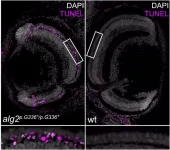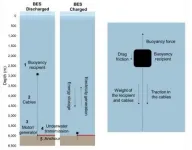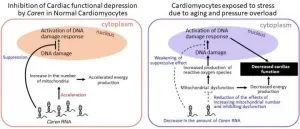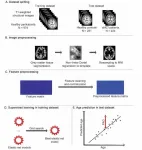Rare genetic defect replicated in fish model
Heidelberg researchers model complex metabolic disturbance
2021-06-23
(Press-News.org) A rare genetic defect that affects the so-called ALG2 gene can cause serious metabolic diseases in humans. It does so through the defective formation of proteins and sugar molecules. Until now, its rareness and complexity made it difficult to study this congenital glycosylation disorder. A research team led by Prof. Dr Joachim Wittbrodt and Dr Thomas Thumberger from the Centre for Organismal Studies (COS) of Heidelberg University has finally succeeded in introducing the underlying mutation in the ALG2 gene in a fish model, thus allowing the causes of these complex diseases to be studied at the molecular level.
Human cells are kept alive by the activity of millions of proteins. As they mature, these proteins must be modified in a myriad of ways, such as through the addition of sugar molecules - a crucial change for proper function. Defects in this sugar-adding process, also known as sugar decoration, are often lethal at the very early stages of development. As Prof. Wittbrodt explains, in rare cases a genetic defect causes sugar-addition deficiencies, which then manifest as congenital disorders of glycosylation. "Correct protein glycosylation requires a number of enzymes functioning together like clockwork," states the researcher. The ALG2 gene has an especially important task in this process. It codes an enzyme needed for the correct branching of the sugar chain. If this process is disturbed, patients appear unaffected at birth but develop problems in different organs, such as the eyes, brain, and muscles, during early childhood.
The team led by Prof. Wittbrodt and Dr Thumberger used the CRISPR/Cas9 gene editing scissors to introduce an ALG2 mutation in a fish model, the Japanese rice fish or medaka. "Fish are particularly good models for these disorders because they develop outside the mother, making them very suitable for studying early embryonic defects," explains Dr Thumberger. In addition, the genome of the Japanese rice fish can be edited efficiently and precisely. "Our fish are genetic twins, so to speak, so the effect of individual changes can be directly identified as compared to non-genetically altered fish."
Although the evolutionary distance between humans and fish is vast, the researchers report many of the same symptoms in the fish model that appear in ALG2 patients, including specific neuronal defects. They were surprised by the results yielded by the analysis of the total medaka organism, which took into account the full spectrum of different cell types. "Although all cells of the fish showed the same reduced ALG2 activity, some cell types were more affected than others," states Prof. Wittbrodt. In the retina of the fish eye, cone cells needed for colour-sensing were unaffected, but there was a progressive loss of rod cells needed for vision in low light, thus rendering the fish night-blind. Now the researchers hope to identify the proteins that cause the rod cells to die off because of diminished sugar binding.
"Our studies on the medaka fish model showed that all symptoms could be prevented by supplying fully functional ALG2 mRNA - the blueprint for producing the correct ALG2 enzyme. We were able to effectively reverse the genetic defect in the fish model. That means that we can now systematically analyse the individual function areas of the ALG2 enzyme. We are particularly interested in the cell type-specific response in the context of the whole organism," stresses Joachim Wittbrodt. Building on this research, the Heidelberg research team plans to study the molecular mechanisms and causes for the development of such complex metabolic diseases in humans.
INFORMATION:
In addition to the Heidelberg team at the COS, researchers from the Center for Molecular Biology of Heidelberg University (ZMBH), Heidelberg University Hospital, and the Max Planck Institute for Dynamics of Complex Technical Systems in Magdeburg joined in the study. The research work was funded by the German Research Foundation. The results of the study were published in the journal "Development".
[Attachments] See images for this press release:

ELSE PRESS RELEASES FROM THIS DATE:
2021-06-23
What do pipes and anchors have to do with storing energy? More than you might think! A new IIASA-led study explored the potential of a lesser known, but promising sustainable energy storage system called Buoyancy Energy Storage.
There is general consensus that renewable energy sources will play an important role in ensuring a healthier and more sustainable future for the planet and its people, and many countries are indeed already seeing such technologies displacing "dirty" fossil fuels in the power sector in an effort to lower emissions. The biggest problem with renewable energy sources, however, is that power supply is intermittent, meaning that the energy output at any given time does not necessarily meet the demand at that time. ...
2021-06-23
Our homes and offices are only as solid as the ground beneath them. When that solid ground turns to liquid -- as sometimes happens during earthquakes -- it can topple buildings and bridges. This phenomenon is known as liquefaction, and it was a major feature of the 2011 earthquake in Christchurch, New Zealand, a magnitude 6.3 quake that killed 185 people and destroyed thousands of homes.
An upside of the Christchurch quake was that it was one of the most well-documented in history. Because New Zealand is seismically active, the city was instrumented ...
2021-06-23
Several eye clinics around Sweden are seeing a rise in eye damage related to the racket sport padel. In an article in the Journal of the Swedish Medical Association (Läkartidningen), eye researchers affiliated with the University of Gothenburg state that padel is a potential high-risk sport for eye injuries, and that wearing protective goggles is a good idea.
Ball sports are often associated with an increased risk of eye injuries, and the risk seems to be even greater with padel, a sport that is now highly popular in Sweden (and should not be confused with the North American "paddle tennis").
"The ...
2021-06-23
ITHACA, N.Y. - Coming soon to a lab tabletop near you: a method of magneto-thermal imaging that offers nanoscale and picosecond resolution previously available only in synchrotron facilities.
This innovation in spatial and temporal resolution will give researchers extraordinary views into the magnetic properties of a range of materials, from metals to insulators, all from the comfort of their labs, potentially boosting the development of magnetic storage devices.
"Magnetic X-ray microscopy is a relatively rare bird," said Greg Fuchs, associate professor of applied and engineering physics, who led the project. "The magnetic ...
2021-06-23
A research collaboration based in Kumamoto University (Japan) has identified a novel lncRNA, Caren, that is abundantly expressed in cardiomyocytes. They showed that it enhances energy production by increasing the number of mitochondria in cardiomyocytes, and inhibits activation of the ATM protein, a key player in the DNA damage response pathway that accelerates heart failure severity. Caren RNA in cardiomyocytes is reduced by aging and high blood pressure (hypertension), which can lead to heart failure, and markedly reduced in the hearts of heart failure patients. The researchers believe that ...
2021-06-23
Eating 2.5 grams of pure natural cocoa powder serves to improve visual acuity in healthy young adults and in daylight conditions, according to research by the Universidad Complutense de Madrid (UCM) and the ICTAN (Institute of Food and Nutrition Science and Technology) of the CSIC.
The study, published in the Journal of Functional Foods, analyse the effects of two dietary polyphenols: cocoa flavanols and red berry anthocyanins.
"Although this was the baseline hypothesis, we did not see any effect either on adaptation to darkness or on visual acuity measured in low light conditions (mesopic vision), either with cocoa or with berries," indicates María Cinta Puell Marín, researcher at the Optometry and Vision ...
2021-06-23
Children who were exposed to higher levels of trace minerals manganese and selenium during their mothers' pregnancy had a lower risk of high blood pressure in childhood, according to a study led by researchers at the Johns Hopkins Bloomberg School of Public Health.
The researchers analyzed the levels of toxic metals and trace minerals in blood samples drawn from nearly 1,200 women in the Boston area who gave birth between 2002 and 2013. They found that higher levels of selenium or manganese in the mothers' blood were associated with lower blood pressure readings in their children ...
2021-06-23
A sensitive blood test being developed by a team of researchers at the University of Michigan Rogel Cancer Center shows promise for predicting whether patients with metastatic HPV-positive throat cancer will respond to treatment months earlier than standard imaging scans.
That's according to a study, published in Oncotarget, validating the test in a small group of patients with metastatic human papillomavirus-related oropharyngeal squamous cell carcinoma -- a type of head and neck cancer that develops in the back of the mouth and in the throat.
If the test can quickly determine that a treatment approach isn't ...
2021-06-23
AMHERST, Mass. - As summer unfolds, more than 500 species of invasive plants will be taking root in fields, lawns, and gardens across the US. As plants continue to move north driven by climate change, the number of invasives will only increase. Unfortunately, inconsistent regulations that vary from state to state means that invasive plants have an edge on our attempts to control them. However, new research from the University of Massachusetts Amherst recently published in the Journal of Applied Ecology suggests that we already have an answer in hand - communication.
"We know that invasive plants are causing both ecological and economic harm in the US," says Emily Fusco, one of the paper's lead authors and a postdoctoral research fellow in the department of environmental conservation ...
2021-06-23
OAK BROOK, Ill. - Researchers have developed an artificial intelligence (AI)-based brain age prediction model to quantify deviations from a healthy brain-aging trajectory in patients with mild cognitive impairment, according to a study published in Radiology: Artificial Intelligence. The model has the potential to aid in early detection of cognitive impairment at an individual level.
Amnestic mild cognitive impairment (aMCI) is a transition phase from normal aging to Alzheimer's disease (AD). People with aMCI have memory deficits that are more ...
LAST 30 PRESS RELEASES:
[Press-News.org] Rare genetic defect replicated in fish model
Heidelberg researchers model complex metabolic disturbance






